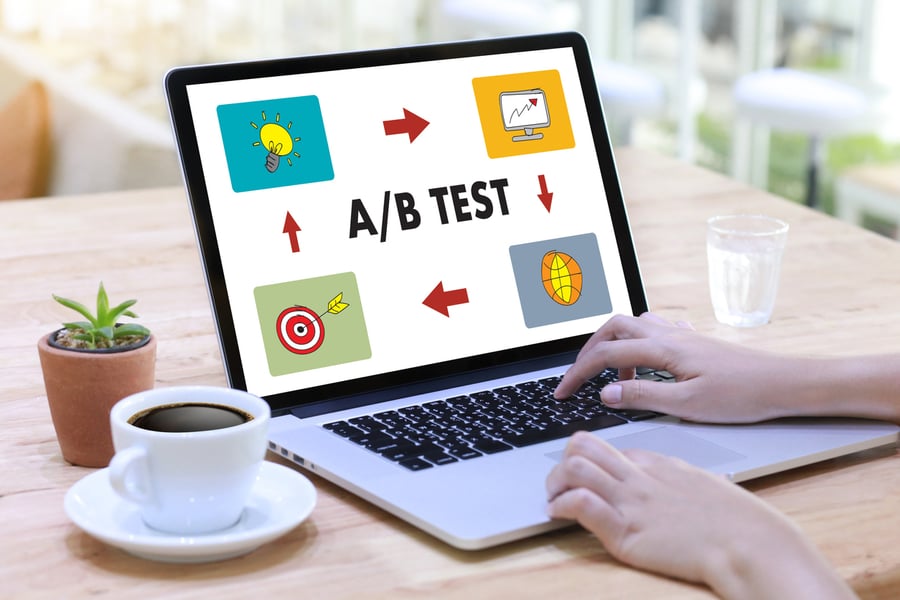
Whether your conversion rates are low, average, or high, there’s always room to optimize better. But without the right methodology, you risk making changes that push your conversion rate in the wrong direction. If you don’t make changes in a controlled way, you won’t even know which change affected your conversion rate.
Wouldn’t it be great if there was an agile testing method for optimizing conversion rates? Thankfully, there is a trusted way of identifying these positive changes: A/B testing.
What Is A/B Testing?
A/B testing: just the name is intimidating, isn’t it? It sounds like something out of robotic process automation, rather than a marketing technique.
And yes – A/B testing does involve some technical and statistical knowledge. But you don’t need to be a math genius to run your own A/B tests. It’s far simpler than it may first appear.
In essence, an A/B test is the marketing equivalent of a controlled experiment in a science lab.
Let’s say you have a landing page that you want to optimize. You know how that page is performing, but you don’t know how it could be improved. A/B testing will help you pinpoint the exact changes that boost your conversion rate on that page.
For example, should your CTA button be blue or green? Should the headline be long or short? Should you have a contact form in the header? A/B testing lets you try all of these variations and compare the difference in conversion rates. And you don’t even need to hire an outsourced software testing team to get started.
How A/B Testing Works
As the name suggests, A/B testing requires (at least) two variations: an “A” and a “B”. The important thing is that the A and B are variations of one variable. The A variation could have a green CTA button, for example, while the B variation could make the same button yellow. In this way, you’re testing like-for-like – and you’ll find out which button color is the best.
And if you’re unsure of the answer to “What is QA testing?”, this is a good time to find out. Otherwise, you risk subjecting your users to a lot of sub-standard features that might harm your business. Be sure to prioritize quality assurance (QA) testing when designing these variations.
It’s important to stick to one change per variation. If you start making multiple changes – such as the button color, and the font size, and the background image – then you won’t be able to say which change affected your conversion rate. If you want to test multiple changes, then you have to create a new A/B test for each change.
And, of course, the test environment has to be controlled. You can’t draw clear conclusions if you show A to 5,000 people and B to 500 people. The audiences have to be of a similar size and demographic, otherwise the results will be skewed.
Finally, you’ll need analytics software set up on your A and B pages. Google Analytics supports A/B testing through its “experiments” feature, for example.
Getting Started with A/B Testing
Just like in a scientific experiment, the first step in A/B testing is creating a hypothesis.
The first question should be: why do you want to optimize this asset? And why now? The answer might be that conversions have dropped off, traffic patterns have changed, or your demographics have shifted. You can get all this information from your analytics dashboard.
At this point, let’s note that A/B testing is just as valuable for a tech company selling BCP software as it is for a restaurant taking bookings online. The goals and principles are exactly the same, no matter your industry.
Once you’ve decided on that goal, get a team together and ask their opinion. You can be sure they all have ideas about why your conversions, traffic, or demographics have changed. This will inform the moves you need to make in response to that change.
Now you can put together an optimization hypothesis. Take this example:
“Removing the ‘phone’ input from our landing page form will increase conversions by 15 percent.”
This is a hypothesis that you can prove or disprove with A/B testing. Your A variation will have the “phone” input, and your B variation won’t. It’s that simple.
What Metrics Can You Test?
While conversion rate is the most obvious metric to test, there are related metrics you can examine as well. If you’re a small online business, you might want to run A/B tests to optimize shopping cart abandonment, for instance. Or if content marketing is a big part of your funnel, you could run A/B tests to optimize time spent on your blog pages.
You should also decide what is statistically significant for your business. If your optimization results could equally have occurred by chance, then you need to repeat the test with a larger sample size, increase the difference between the A and B variations, or produce more consistent results.
How Do You Set Up Testing Groups?
The idea of A/B testing is that your users aren’t aware that they’re taking part in an experiment. This is because you want to see how users react to your changes in the wild, where your eCommerce conversion rates will really matter.
There are analytics tools out there that will automatically direct the same number of users to your A variation and your B variation. By randomizing who sees which page, and keeping the sample sizes the same, you ensure a fair test and objective results. You can also do this for emails with a random 50/50 split of your mailing list.
Running Your A/B Test
An A/B test could take a few hours or a few weeks, depending on your user base and the statistical significance you want to achieve. If you have a large mailing list, then you can send A/B emails and get results instantly. This means a fast improvement to your email design.
However, if you want to A/B test a web page with low traffic, you’ll have to wait for a significant number of visitors to pass through your analysis.
What to Do with A/B Test Results
If your test has yielded statistically significant results, that’s great. But A/B testing isn’t a purely academic exercise: you want to make impactful changes after you’ve received all of the data.
Sometimes you have to weigh the benefit of a recommended change against the cost of implementing it. If the change is as simple as sending a different email headline, then that’s a clear win. If the change involves re-developing hundreds of web pages, however, then you need to show that the benefit outweighs the cost.
My Test Didn’t Show Anything! What Now?
Scientists say that there’s no such thing as a failed experiment because every experiment tells you something. In some cases, it may tell you that there is no significant difference between your A and B variations. If that’s true, you don’t need to change your shopping cart software or whatever else you were testing.
On the other hand, you might want to alter the experiment. Creating a stronger difference between your variations and running the experiment again may provide a more significant result. Alternatively, you can keep testing different variations of the same asset until you find the key element for your metric.
The Top Elements for A/B Testing

1. Headlines and Body Copy
When it comes to writing, there are many ways to skin a cat. First, there’s the information you select as a source. Secondly, there’s the tone. Thirdly, there’s the copy structure. Fourthly, there’s a near-infinite number of variations on a word-by-word basis.
Each of these points can be highly subjective. It’s hard to know whether people will be more engaged by the title “Reducing customer service response time” or “Halve your customer service response time instantly,” for example.
This is why headlines and copywriting are a great place for A/B testing. Even if you don’t understand why readers prefer A over B, the tests will provide the answer.
Things you can test include short-form vs long-form copy, hard selling vs soft selling, and factual storytelling vs emotional storytelling.
2. Calls to Action
Your CTAs should be so attuned to your target audience that they’re irresistible. Minor changes to the wording, styling, and position of a CTA can make a big difference in its effectiveness.
Successful online businesses are constantly testing variations in the color, size, contrast, and shape of their “Buy now” buttons. Something as simple as keeping a CTA button fixed to the bottom-right of the screen can increase conversions by a huge margin.
As always, don’t try changing too many CTA characteristics at once. Stick to a single variation – a rounded button instead of square-edged, for instance – and see how that impacts conversions. If the change is a winner, implement that and move on to the next test. By the time you’ve done twenty tests, your CTA buttons will be highly optimized.
3. Images and Video
Much like we described for copywriting, you can create variations of images and videos to see which works best.
With images, there are so many potential variations that you’ll have trouble testing them all. These range from image selection, size, placement, colored overlays, saturation, contrast, and every other effect you can think of. For this reason, it’s better to stay within the pre-defined boundaries of your brand and the asset you’re working with.
The characteristics you test will depend on the action you’re hoping to optimize: if it’s clicking a button, for example, you can test an image that flows toward the button versus a more neutral background image.
4. Email Subject Lines
The subject line is the first thing your recipients see – before they open the email or perhaps delete it. So, optimizing email subject lines is a powerful way to increase your open rates.
Because subject lines are short, they are also a quick win for testing multiple variations. Get out your copywriting manual and try every trick in the book. If you normally write statements, test that against a question instead. Try with emojis and without. Try an emotional hook against an eye-catching statistic. Start the same sentence with a range of imperative verbs like “get,” “see,” “experience,” “taste,” “enjoy” or “benefit.”
Don’t think that this approach only applies to sales emails. You can apply the same principles to the automated emails sent from your helpdesk ticketing system, for instance.
5. Content Detail
When it comes to content, less can be more. On the other hand, more can also be more. The decision rests with your readers – and you can find out their preference through A/B testing.
If your readership wants a quick overview, then too much in-depth content will put them off. Rather than read your detailed copy, they’ll click away.
But if your readers want to know the nitty-gritty, then a light introduction won’t satisfy them. A high-level page will quickly lose their interest.
This goes for landing pages as well as blog pages. By performing A/B testing with a high-level page versus an in-depth page, you’ll find out exactly how much your readers want to know before they convert.

6. eCommerce Product Descriptions
In eCommerce product descriptions, short and snappy is the norm. You want to get the relevant specs and differentiators on the page – without going into lengthy detail.
At least, this is true for eCommerce when the product itself is simple and when there aren’t many comparisons to be made. If you’re selling posters, for example, then an image says 99% of what customers need to know.
If you’re selling a camera lens, on the other hand, there are a lot of technical specs and practical benefits to consider. Is it light? Is it durable? How powerful is the zoom? What does it shoot well? By covering the right questions, in the right order, with the right tone and facts to back them up, your customers will be more likely to convert.
And, you guessed it – you can discover the perfect eCommerce description for your products and your audience through A/B testing. This is a process of trial and error, but with persistence, you’re sure to learn what your audience wants to hear.
7. Social Proof
With so much competition online, customers aren’t sure who they can trust. That’s why social proof is so important for convincing potential buyers that you’re the best option.
Social proof can consist of written reviews, video testimonials, and star ratings.
To find out which of these works best, you can conduct A/B testing. Make a table of the different variations of social proof you have and cross-test each one against the others. By the end of this, you’ll have weeded out the weak options and found yourself a champion.
What’s Next?
While A/B testing can initially seem daunting, there are countless CMS (content management systems) that support and analyze A/B test results, clearing the path to increased sales. Minor changes in the color palette, font size and shape, or writing tone and style might seem irrelevant and ineffectual but could lead to maximizing your conversion rate. Now’s the time to get scientific and don that A/B lab testing coat.





Leave a reply or comment below